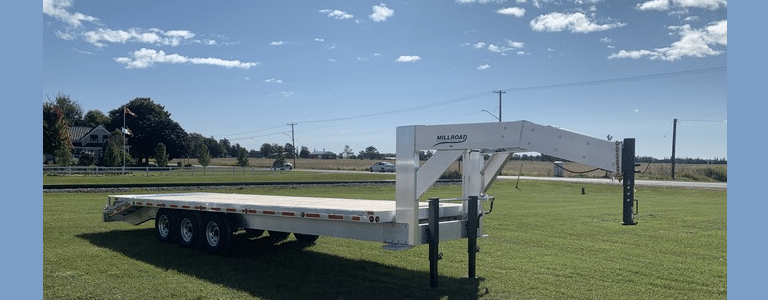
December 29, 2020 Last updated on June 16, 2023 by Bob Fisher Bob Fisher Gooseneck/Fifth Wheel Trailers
When looking up cargo trailer options, you may have come across the bumper pull versus gooseneck trailer debate. Some people swear by the ease of use of a bumper pull, while others prefer the stability of a gooseneck. Another benefit often mentioned is the gooseneck’s ability to handle more weight, but is that really true?
Gooseneck trailers are towed using a hitch, mounted in the bed of your truck. To facilitate this design quirk, gooseneck trailers raise upward and stretch into the bed of the truck. When enclosed, this may create a second floor for changing or additional storage. Consequently, they are often taller than most bumper pulls. More often than not, to attach a gooseneck trailer to your truck, you use a gooseneck hitch.
A testament to the higher weight limit of goosenecks is that they are far more likely to be classed as commercial trailers. This is because so many of them have gross vehicle weights above the commercial threshold.
Gooseneck trailers accommodate higher payloads because the trailer’s tongue weight is over the rear axle of your truck, instead of all forced down onto the back of the frame. This improves stability. Trailer manufacturers then use higher-capacity axles to take on more weight.
Even though gooseneck trailers can haul more weight, it doesn’t mean you can automatically tow more weight. For instance, goosenecks have payload weights you need to observe. Here are some additional factors to consider.
Every truck comes with a towing capacity. You can usually find this information in the manual or in the driver’s side door of your vehicle. This will tell you how much you can safely tow with your vehicle. Note that if you have modified your vehicle, this may affect how much you can tow.
Even if you believe your vehicle should tow more, the insurance company may disagree and refuse to cover some incidents. A good rule of thumb is to tow at 80% or less of your towing capacity.
One common truck modification is installing lifts. This can help you clear obstacles during the winter or while travelling on dirt roads, but it can reduce the tow quality of your vehicle. Without additional modifications to counter sag, you could wear out the suspension in your truck.
If you’ve upgraded your tire sizes, you may have very little space left in the wheel well. This runs the risk of the metal rubbing on your tire.
Bumper trailers are more common among novice trailer owners while towing veterans tend to choose gooseneck trailers. One reason for this is the more weight you tow, especially on roads used by passenger vehicles, the more risk you pose to others and yourself.
It’s important to learn how your gooseneck trailer behaves differently at various weights. You can then decide how much you’re comfortable towing.
If you tow with a high-mileage vehicle, you may want to reconsider how much weight you put in your trailer. Towing puts additional stress on the engine and the transmission. This can cause additional wear-and-tear on vehicles that are likely already nearing the end of their product cycles.
You can reduce these risks by keeping up with maintenance as best as possible. Regardless of the mileage on any vehicle, you will have more maintenance when you use it to tow more often.
Gooseneck trailers are not always as easy to come by as bumper pulls. At Millroad Manufacturing, we provide a wide range to choose from.